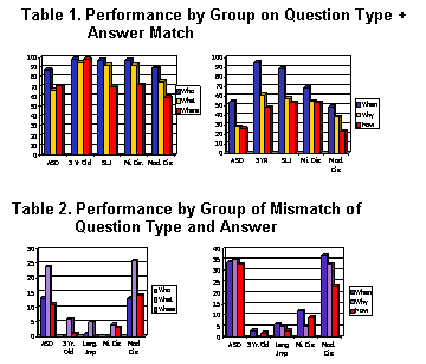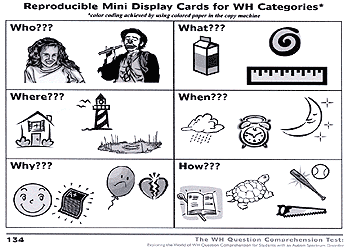The Need for Good Question Comprehension
“Who,” “what,” “when,” “where,” “why,” and “how” are among the most powerful words in our language. From early childhood these words form the basis of personal interactions and instruction. Parents playfully ask their toddlers, “Who’s that? as they point to the child’s reflection in the mirror, “Where’s your tummy?” as they teach the names of body parts, and ask “What’s that?” as they point to a flower. Teenagers might ask each other “What will you wear to the party Friday night?” “Who is going with you?” “How will you get there?” Even as adults these words are common in everyday interactions as a co-worker may ask, “When is the project due?” “Why are you upset?” “How can I help you?” It is hard to imagine a day without using these questions. In our society, asking questions serves the function of obtaining new information, verifying old information, getting acquainted, starting a conversation or maintaining it, checking the understanding of someone else, looking for common ground, stalling, and a myriad of other reasons.
Understanding and being able to respond to questions is important to everyone, including children and adults with special challenges or disabilities. Because the typical child seems to develop an understanding of these question forms during early childhood without overt instruction from adults, it is easy to forget that this may not be the case for everyone. There are groups of individuals who may need assistance in learning to understand question forms and in learning to use these skills to become better partners in daily interaction.
Who [i.e. which children or students] might need assistance, unfortunately, isn’t always apparent from personal observation. The ability of someone to ask certain WH question types does not necessarily mean that he or she has the ability to answer or understand the same WH question type when it is posed by someone else. Accurate question comprehension is also influenced by other factors. While one may understand what is normally expected when asked a What question, comprehension in natural setting may depend on how well one is paying attention, how easy it is to stay focused while listening, the degree of competing noise, and one’s expectations about the message. Because of this unexpected discrepancy between comprehension and expressive use, comprehension problems in certain individuals may not be anticipated or recognized.*
Checking on Student Comprehension
of WH Questions: Brief Highlight
Based on a study sponsored by the Indiana Resource Center for Autism (IRCA), it is recommended that most verbal students with autism spectrum disorder (ASD) who are four years of age and older be screened for WH question comprehension. Although the IRCA study was small, only 28 students with ASD, performance on The WH Question Comprehension Test (Vicker, 2002) was not reliably predictable based neither on the age of a student nor on an adult’s informal global perception of mastery. In the study, students ranged from age 4-12; several younger children clearly outperformed many of the older students. The performance of the group with ASD was compared to several other subgroups, including a group of 10 typical three year olds. Only 8 out of 28 students with ASD scored better than the typical three year olds. Only 2 out of 28, an 8 year old and a 10 year old scored a perfect score in all six categories of short, familiar questions.
Students were not evaluated for accuracy of response but instead were evaluated on whether the answer matched the question form. When ten Who questions were asked, ten answers relating to people were expected, even if the answers were not technically correct. For example, “Mommy” was sometimes a common answer from the younger children to the question “Who lives in a castle?” “Mommy” was considered a correct answer since it was a person related response.
A common error for the group with ASD was what is called a mismatch. This meant that a child answered a question as if a different question form had been asked. For example, although 87% of Who questions included a person response for the group with ASD, students also answered a Who question as if a What, Where, or When question had been asked. The typical three year olds never answered a Who question with anything but a person answer. This pattern was repeated across blocks of What, Where, When, Why and How questions with the scores decreasing for the ASD group as a whole.

Using a Visual Support: One Strategy
The percentage scores for performance between groups on various questions is not the most important suggestion coming from the study; different percentages might be obtained if the sample had been larger. Instead, what is important is the need to identify who is fine in terms of understanding basic WH questions and who needs instruction. Secondly, even for those who seem to have competency with question form when the sentences are short and about familiar information, the question looms, what happens in the classroom amid all the noise and distraction. Is the child who is competent in one situation, less competent under changed circumstances? And if judged less competent in the latter circumstances, what can be done to assist that student?
Many different strategies might be used to enhance instruction and to assist focus in the classroom regarding WH question comprehension. This article is only going to focus on one, a visual support.

The WH Question visual support can be used in several ways. First of all an enlarged version of the support could be posted in front of a classroom and a teacher could point to it as she asked questions of the class. The graphic would represent a visual support for her orally asked question. If previous instruction had taken place relative to the question forms and the meaning of the picture cues, then use of the graphic should be meaningful to the student. Another option for the teacher would be to cut apart the question displays and run each off on a different colored piece of paper; this could provide a color cue as well as a symbol based cue. Finally, the teacher could have a miniature copy of the display on the desk of the child with ASD who is still learning the question forms or who needs support to stay focused. The teacher could point to the appropriate category on the child’s desk as she or he asks a question of the class.
Question comprehension is important. Some children may learn to match form and response from instruction in the classroom. Others may need more intensive small group instruction. Regardless of setting, a simple visual support might be an important tool to use to aid the student’s progress.
* Excerpt from Vicker, B. (2002). The WH Question Comprehension Test: Exploring the world of WH question comprehension for students with an autism spectrum disorder. (pp. 5-6). Bloomington, IN: Indiana Institute on Disability and Community.
Vicker, B. (2004). Using a visual support to enhance WH question comprehension. The Reporter 9(3), 9-10.

